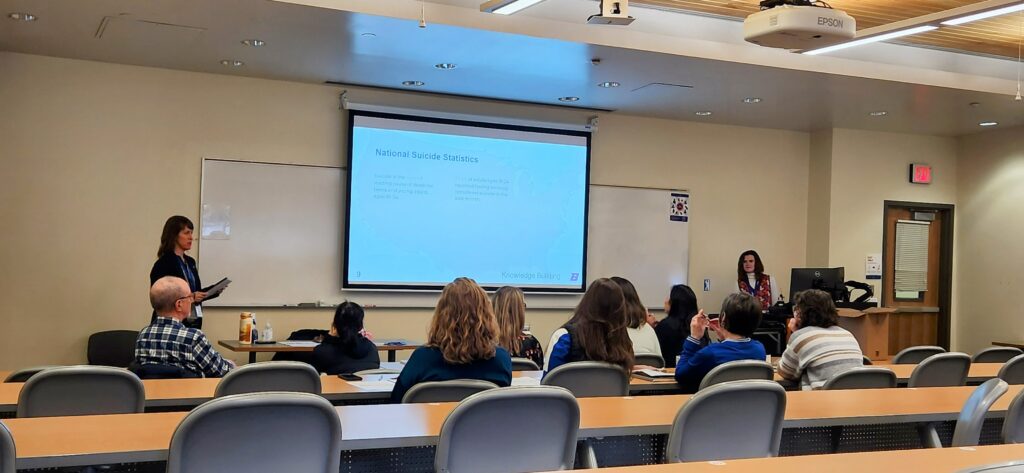Suicide Prevention Training
If your department would like to request suicide prevention training from the Here For You team, please submit a training request form. Currently, training is only available on a department/group level. As the training model expands, we will offer individual sign-ups. Thank you for your patience.
Upcoming Sessions
Fall 2025 Dates To Be Announced
I’m a Certified Here For You Gatekeeper, Now What?
Being a certified suicide prevention gatekeeper means you can:
- Help to educate others on the widespread impact that suicide has on our society.
- Dispel some of the myths surrounding suicide and mental illness.
- Recognize some of the risk factors and warning signs for suicide
- Directly ask about suicide, using appropriate an precise language.
- Respond with empathy to those struggling.
- Act as a bridge between people in distress and helpful resources.
Here For you: Suicide Prevention Training FAQs

Q: How do I schedule/request a training?
You can request a training by clicking here
Q: What is a gatekeeper/gatekeeper training?
A gatekeeper is someone who is in a position to recognize and respond to signs of distress or crisis in others, particularly those that may indicate a risk of suicide. Gatekeepers are often individuals who regularly interact with people in their community or organization, such as teachers, healthcare providers, coaches, supervisors, or even peers. Their role is not to act as professional counselors or therapists but to identify warning signs, provide initial support, and connect individuals to appropriate resources.
Gatekeeper training equips individuals with the knowledge and skills to recognize and respond to signs of distress, mental health challenges, or suicide risk in others. Participants learn to identify warning signs, approach individuals compassionately, provide initial support, and connect them to appropriate resources. Key components of these programs include raising awareness about mental health and suicide risk factors, practicing conversations about sensitive topics, learning to ask direct questions, and understanding available support networks such as crisis hotlines or mental health services.
Q: Why is gatekeeper training important?
Gatekeeper Training is essential because it empowers individuals to play a critical role in preventing crises and saving lives. By equipping community members with the skills to recognize warning signs of distress or suicide risk, gatekeeper training fosters early identification and intervention, which can significantly reduce the likelihood of tragic outcomes. It creates a network of informed and compassionate responders who can provide immediate support and guide individuals to professional help when needed.
Q: Can you provide access to original training materials (powerpoint, training videos, manuals)?
Unfortunately, we are unable to share original materials, such as PowerPoint slides, training videos, or manuals, outside of our certified training sessions. These resources are designed to be delivered as part of a structured program led by trained facilitators to ensure participants receive accurate information and engage in interactive, supportive learning experiences.
Q: What are some resources you would recommend related to suicide prevention?
Organizations and Support Networks
- American Foundation for Suicide Prevention (AFSP): Offers education, research, and advocacy for suicide prevention.
Website: afsp.org - National Alliance on Mental Illness (NAMI): Provides support groups, resources, and education for individuals and families affected by mental illness.
Website: nami.org - Jed Foundation (JED): Focuses on suicide prevention and emotional health among teens and young adults, particularly in educational settings.
Website: jedfoundation.org
Resources for Specific Populations
- Veterans Crisis Line: Call 988 and press 1, or text 838255, for confidential support tailored to veterans and their families.
Website: veteranscrisisline.net - Suicide Prevention Resource Center (SPRC): Provides tailored resources for professionals, community leaders, and educators.
Website: sprc.org - SAMHSA’s Behavioral Health Treatment Services Locator: Helps find mental health and substance use services near you.
Website: findtreatment.samhsa.gov
Crisis Hotlines and Text Services
The Trevor Project: Offers specialized support for LGBTQ+ youth. Call 1-866-488-7386, text START to 678678, or chat online.
Website: thetrevorproject.org
988 Suicide & Crisis Lifeline (U.S.): Call or text 988 for free and confidential support 24/7. Available for anyone in distress, concerned for a loved one, or seeking resources.
Website: 988lifeline.org
Crisis Text Line: Text HOME to 741741 to connect with a trained crisis counselor.
Website: crisistextline.org
Q: Who can I contact to learn more about HFY training?
Please contact Anna Moreshead (annamoreshead@boisestate.edu) or Chris Amezcua (chrisamezcua@boisestate.edu) for more information.
Participant Breakdown
Total Number of Participants
Guiding Evidence
Boise State’s Here For You: Suicide Prevention Training is informed by extensive research and expert guidance.
References
- Adams, L. M., Nguyen, T., Morgan, K. B., & Gumbleton, C. (2018). RU OK: Evaluating the Effectiveness of a Gatekeeper Training Program. Journal of College Student Development, 59(5), 614–617.
- Gomes, A. L., & Silva, M. J. (2022). The role of teachers in youth suicide prevention: A scoping review. International Journal of Environmental Research and Public Health, 19(18), 11368.
- Holmes, G., Clacy, A., Hermens, D., & Lagopoulos, J. (2019). The Long-Term Efficacy of Suicide Prevention Gatekeeper Training: A Systematic Review. Archives of Suicide Research, 25, 1–31. https://doi.org/10.1080/13811118.2019.1690608
- Lamis, D. A., Underwood, M., & D’Amore, N. (2017). Outcomes of a suicide prevention gatekeeper training program among school personnel. Crisis: The Journal of Crisis Intervention and Suicide Prevention, 38(2), 89–99. https://doi.org/10.1027/0227-5910/a000414
- Sylvara, A. L., & Mandracchia, J. T. (2019). An investigation of gatekeeper training and self-efficacy for suicide intervention among college/university faculty. Crisis: The Journal of Crisis Intervention and Suicide Prevention, 40(6), 383–389.